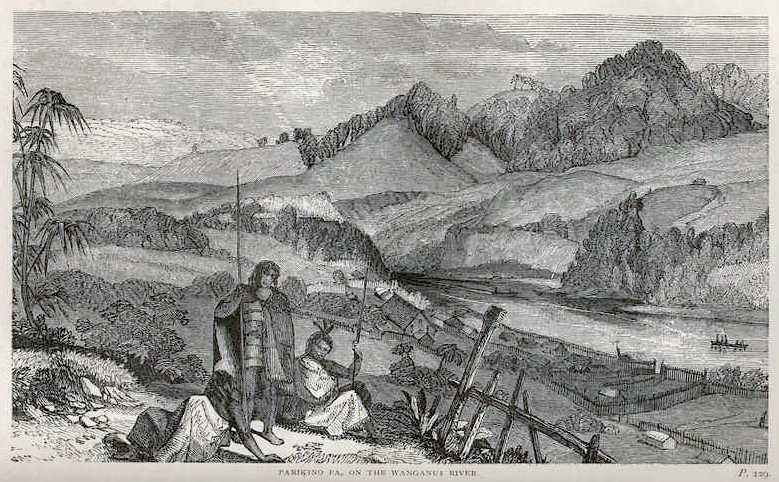Parikino Pa on:
[Wikipedia]
[Google]
[Amazon]
 Parikino is a settlement upriver from Whanganui, New Zealand; the original
Parikino is a settlement upriver from Whanganui, New Zealand; the original
Ans Westra's Parikino photos
{{coord, 39, 48, S, 175, 09, E, display=title, region:NZ_type:city_source:GNS-enwiki Whanganui River Populated places in Manawat≈´-Whanganui Settlements on the Whanganui River Whanganui District
 Parikino is a settlement upriver from Whanganui, New Zealand; the original
Parikino is a settlement upriver from Whanganui, New Zealand; the original pā
The word pā (; often spelled pa in English) can refer to any Māori village or defensive settlement, but often refers to hillforts – fortified settlements with palisades and defensive terraces – and also to fortified villages. Pā sites o ...
site was across the Whanganui River.
Parikino was originally a fortified settlement established in 1845 as security against a possible raid by a Ngāti Tūwharetoa ''taua'' (war party). The population of about 200 then gradually moved to the unfortified agricultural land across the river. Parikino is home to the Ngāti Hinearo
Iwi () are the largest social units in New Zealand Māori society. In Māori roughly means "people" or "nation", and is often translated as "tribe", or "a confederation of tribes". The word is both singular and plural in the Māori language, an ...
and Ngāti Tuera
Iwi () are the largest social units in New Zealand Māori society. In Māori roughly means "people" or "nation", and is often translated as "tribe", or "a confederation of tribes". The word is both singular and plural in the Māori language, an ...
hapū of the iwi Te Āti Haunui-a-Pāpārangi. The Ngāti Hinearo wharenui is called Te Aroha, and the Ngāti Tuera is Wharewhiti.
The meeting house Maranganui Tuarua, 3 km south of Parikino at Pungarehu, was built for Ngāti Tuera by the carver Hōri Pukehika.
Parikino Sports Day, consisting mainly of horseback competitions and family activities, has run every year since 1928; farm chores are traditionally put on hold for the day.
One of New Zealand's most important contemporary photographers Ans Westra took a series of black-and-white photographs of children and teachers at the Parikino Maori School in 1963.
There are three marae in the Parikino area. Parikino Marae
Parikino is a settlement upriver from Whanganui, New Zealand; the original pā site was across the Whanganui River.
Parikino was originally a fortified settlement established in 1845 as security against a possible raid by a Ngāti Tūwharetoa ' ...
and Ko Wharewhiti or Te Aroha meeting house are a meeting place for Ngāti Hinearo
Iwi () are the largest social units in New Zealand Māori society. In Māori roughly means "people" or "nation", and is often translated as "tribe", or "a confederation of tribes". The word is both singular and plural in the Māori language, an ...
and Ngāti Tumango
Iwi () are the largest social units in New Zealand Māori society. In Māori roughly means "people" or "nation", and is often translated as "tribe", or "a confederation of tribes". The word is both singular and plural in the Māori language, an ...
. Ātene or Kakata Marae and Te Rangi-i-heke-iho meeting house are affiliated with Ngāti Hineoneone
Iwi () are the largest social units in New Zealand Māori society. In Māori roughly means "people" or "nation", and is often translated as "tribe", or "a confederation of tribes". The word is both singular and plural in the Māori language, an ...
. Pungarehu Marae
Parikino is a settlement upriver from Whanganui, New Zealand; the original pā site was across the Whanganui River.
Parikino was originally a fortified settlement established in 1845 as security against a possible raid by a Ngāti Tūwharetoa ' ...
and Maranganui Tuarua meeting house are affiliated with Ngāti Tuera
Iwi () are the largest social units in New Zealand Māori society. In Māori roughly means "people" or "nation", and is often translated as "tribe", or "a confederation of tribes". The word is both singular and plural in the Māori language, an ...
.
Education
Aberfeldy School is a co-educational state primary school for Year 1 to 8 students, with a roll of as of .References
External links
Ans Westra's Parikino photos
{{coord, 39, 48, S, 175, 09, E, display=title, region:NZ_type:city_source:GNS-enwiki Whanganui River Populated places in Manawat≈´-Whanganui Settlements on the Whanganui River Whanganui District